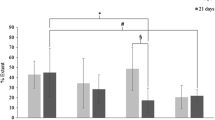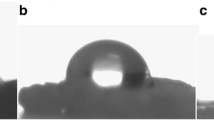Abstract
Purpose
The polypropylene mesh used for the repair of abdominal wall hernia can cause intraabdominal adhesions. In this study, the effect of chitosan coating of the polypropylene meshes on the adhesion and tensile strength of the meshes was investigated.
Method
After coating polypropylene meshes with 2 % chitosan, 5 × 3 cm patches were prepared. Under general anesthesia, sterile laparotomy was performed in 96 Wistar albino female rats that were equally allocated to 6 groups. In the first group, only laparotomy was performed. In the second group, chitosan was applied to the peritoneal cavity, and the laparotomy was closed. In the third group, polypropylene (prolene) patches were used to close the abdomen; in the fourth group, polypropylene polyglecaprone 25 (ultrapro) mesh patches were used to close the abdomen. In the fifth and sixth groups, chitosan-coated versions of the meshes used in the third and fourth groups, respectively, were applied. All skin incisions were closed in all groups. On the 7th and 21st days, eight randomly selected rats from each group were killed. The abdomen was opened, and the adhesions were evaluated using the diamond score. The tensile strength of the meshes was measured by an Instron 4301 device. The histopathological evaluation of the inflammatory response was performed according to the Ehrlich and Hunt classification.
Results
The adhesion score was comparable among mesh groups but higher when mesh groups were compared with the control and chitosan groups (p<0.001). The tensile strength of meshes did not differ among mesh groups. Histopathologically, meshes with or without chitosan were similar in terms of inflammatory findings.
Conclusions
The chitosan coating did not affect the adhesion potential, the tensile strength, or the inflammatory response of the polypropylene meshes.
Similar content being viewed by others
References
Usher FC, Ochsner J, Tuttle LL Jr (1958) Use of marlex mesh in the repair of incisional hernias. Am J Surg 24:969–974
Losanoff JE, Richman BW, Jones JW (2002) Entero-colocutaneous fistula; a late consequence of polypropylene mesh abdominal wall repair: case report and review of the literature. Hernia 6:144–147
Irkorucu O, Ferahköşe Z, Memiş L, Ekinci Ö, Akın M (2009) Reduction of postsurgical adhesion in a rat model: a comparative study. Clinics 64:143–148
Ozturk E, Yılmazlar A, Berhuni S, Yılmazlar T (2010) The effectiveness of local anasthetics in preventing postoperative adhesions in rat models. Tech Coloproctol 14:337–340
Topal E, Ozturk E, Sen G, Yerci O, Yılmazlar T (2010) A comparison of three fibrinolytic agents in prevention of intraabdominal adhesions. Acta Chir Belg 110:71–75
Yılmazlar T, Kaya E, Gürpınar E, Emiroğlu H (1996) Efficacy of tenoxicam on intra-abdominal adhesion prevention in a rat model. J Int Med Res 24:352–357
Bachman S, Ramshaw B (2008) Prostetic material in ventral hernia repair: how do I choose? Surg Clin N Am 88:101–112
Alves NM, Mano JF (2008) Chitosan derivatives obtained by chemical modification for biomedical and environmental applications. Int J Biol Macromol 43:401–414
Rao SB, Sharma CP (1997) Use of chitosan as a biomaterial:studies on its safety and hemostatic potential. J Biomed Mater Res 34:21–28
Shankaran V, Weber DJ, Reed L (2011) Areview of prosthetics for ventral hernia repair. Ann Surg 253:16–26
Brown CN, Finch JG (2010) Which mesh for hernia repair? Ann R Coll Surg Engl 92:272–278
Schneider A, Bennek J, Olsen K (2006) Experimental study evaluating the effect of a barrier method on postoperative intraabdominal adhesions. Dig Dis Sci 51:566–570
Phillips JD, Kim CS, Folkalsrud EW (1992) Effects of chronic corticosteroids and vitamin A on the healing of intestinal anastomoses. Am J Surg 163:71–77
Zhou J, Elson C, Le TD (2004) Reduction in postoperative adhesion formation and re-formation after an abdominal operation with the use of N, O-carboxymethyl chitosan. Surgery 135:307–312
Risbud M, Hardikar A, Bhonde R (2000) Growth modulation of fibroblasts by chitosan-polyvinyl pyrrolidone hydrogel: implications for wound management? J Biosci 25:25–31
Van der Wal JB, Jeekel J (2007) Biology of the peritoneum in normal homeostasis and after surgical truma. Colorectal Dis 9:9–13
Zhang Z, Xu S, Zhou X (2006) Preventive effects of chitosan on peritoneal adhesion in rats. W J Gastroenterol 28:4572–4577
Zhou X, Chen S, Liao G et al (2007) Preventive effective of gelatinizedly-modified chitosan film on peritoneal adhesion of different types. World J Gastroenterol 13:1262–1267
Costain DJ, Kennedy R, Ciona C (1997) Prevention of postsurgical adhesions with NO-carboxymethyl chitosan: examination of the most efficacious preparation and the effect of NO-carboxymethyl chitosan on postsurgical healing. J Surg 121:314–319
Junge K, Rosch R, Krones CJ (2005) Influence of polyglecaprone 25 (Monocryl) supplementation on the biocompatibility of a polypropylene mesh for hernia repair. Hernia 9:212–217
Novitsky YW, Harrell AG, Cristiano JA (2007) Comparative evaluation of adhesion formation, strength of ingrowth, and textile properties of prosthetic meshes after long-term intraabdominal implantation in a rabbit. J Surg Res 140:6–11
Junge K, Binnebösel M, Rosch R (2009) Adhesion formation of a polyvinylidenfluoride/polypropylene mesh for intra-abdominal placement in a rodent animal model. Surg Endosc 23:327–333
Kramer K, Senninger N, Herbst H (2002) Effective prevention of adhesions with hyaluronate. Arch Surg 137:278–282
Riet M, Burger WA, Bonthuis JJ (2004) Prevention of adhesion formation to polypropylene mesh by collagen coating. Surg Endosc 18:681–685
Scheidbach H, Tamme C, Tannapfel A (2004) In vivo studies comparing the biocompatibility of various polypropylene meshes and their handling properties during endoscopic total extraperitoneal (TEP) patchplasty. Surg Endosc 18:211–220
Voskerician G, Jin J, Hunter SA (2009) Human peritoneal membrane reduces the formation of intra-abdominal adhesions in ventral hernia repair: experimental study in a chronic hernia rat model. J Surg Res 157:108–114
Cobb WS, Burns JM, Peindl RD (2006) Textile analysis of heavy weight, mid-weight, and light weight polypropylene mesh in a porcine ventral hernia model. J Surg Res 136:1–7
Çakmak A, Çirpanli Y, Bilensoy E (2009) Antibacterial activity of triclosan chitosan coated graft infection model. I J Pharm 381:214–219
Acknowledgments
This study was supported by the Research Fund of Uludag University.
Conflict of interest
The authors declare no conflict of interest with any organization.
Ethical standards
The experiments complied with the current laws of Turkey.
Author information
Authors and Affiliations
Corresponding author
Rights and permissions
About this article
Cite this article
Altınel, Y., Öztürk, E., Özkaya, G. et al. The effect of a chitosan coating on the adhesive potential and tensile strength of polypropylene meshes. Hernia 16, 709–714 (2012). https://doi.org/10.1007/s10029-012-0950-1
Received:
Accepted:
Published:
Issue Date:
DOI: https://doi.org/10.1007/s10029-012-0950-1




